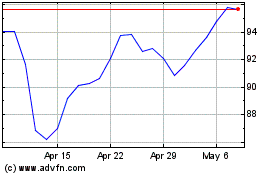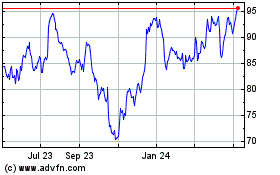By Liz Hoffman and Peter Rudegeair
Morgan Stanley 's profit fell 12% in the second quarter as the
company weathered volatile markets but exceeded a trading target
set by the company's chief executive last month.
The bank's earnings and revenue easily beat subdued
expectations, pushing shares up 2% in morning trading. The New York
firm's results wrap up a second-quarter reporting season for big
U.S. banks in which earnings mostly fell but trading activity, the
biggest single source of Wall Street fees, showed signs of
life.
Morgan Stanley's net income declined to $1.58 billion, or 75
cents a share, from $1.81 billion, or 85 cents a share, a year
earlier. Analysts polled by Thomson Reuters had expected a
per-share profit of 59 cents.
Revenue fell 8.6% to $8.91 billion, but topped the $8.3 billion
forecast by analysts.
Morgan Stanley, the last of the major U.S. banks to report
earnings, didn't get the same trading bump most of its rivals
reported. Revenue in the closely tracked unit fell 2%, excluding an
accounting adjustment, to $3.26 billion from $3.32 billion a year
ago.
Most other banks reported double-digit increases in trading
revenue as clients shook off first-quarter jitters and Britain's
vote to leave the European Union generated a flurry of late-quarter
trading activity.
Still, analysts expected an even sharper drop. In fixed-income
and commodities trading, where the firm has cut staff and set a $1
billion quarterly revenue target, Morgan Stanley reported
second-quarter revenue of $1.3 billion.
"There was a general overreaction to the underperformance" of
the fixed-income business last year and through the first quarter,
Chairman and CEO James Gorman said on a conference call. "Yes, it's
a good number this quarter. Are we shocked by it? Not really."
In stock-trading, where Morgan Stanley has long been Wall
Street's leader, revenue fell 5% excluding an accounting
adjustment, though the bank gained market share from its chief
rival in the space, Goldman Sachs Group Inc. It also was facing a
tough comparison with 2015, when a second-quarter surge trading in
Asia boosted revenue in the equities division.
Investment-banking revenue fell 23% to $1.11 billion from $1.44
billion in the second quarter of 2015. Fees from advising on
mergers and other deals rose 17% to $497 million, while revenue on
stock and bond underwriting slipped 40% to $611 million from $1.02
billion in the same period a year prior.
Overall, the bank's results "should be good enough for the
[Morgan Stanley] recovery to march on," Evercore ISI analyst Glenn
Schorr wrote.
Mr. Gorman, Morgan Stanley's CEO since 2010, has been working to
boost profitability by trimming the capital committed to
bond-trading desks and boosting loans to investing clients of the
firm's large wealth-management division. Earlier this year, the
firm also disclosed its aim to cut $1 billion in expenses, a theme
that has gained momentum at banks from Goldman Sachs to Bank of
America Corp. this quarter.
Morgan Stanley showed progress on both of those goals in the
second quarter. Loans to wealth-management clients grew 19% to a
record $69 billion. That, plus a double-digit-percentage increase
in corporate loans, lifted the bank's loan book to nearly $200
billion, which helped raise net interest income.
Meanwhile, firmwide expenses fell 8.4% to $6.43 billion from
$7.02 billion in the second quarter last year. Cost from employee
pay and benefits fell 8.9%, mostly mirroring declining revenue.
Late last year, Morgan Stanley cut 25% of its trading staff as part
of a firmwide cost-trimming effort dubbed Project Streamline.
Chief Financial Officer Jonathan Pruzan reiterated plans to
close data centers and move headcount from high-cost cities to
cheaper regions. He said non-essential travel fell by 50% through
the six months of this year compared with 2015, and pointed to
savings measures like a new online procurement system the bank
recently put in place.
Return on equity declined to 8.3% from 9.1% in the second
quarter of 2015, but increased from 6.2% in the first quarter. The
metric is a closely watched measure of banks' profitability and is
especially key for Morgan Stanley, where executives have pledged to
lift returns to between 9% and 11% by 2017.
Revenue in the wealth-management division, Morgan Stanley's
second largest, fell 1.7% to $3.81 billion, though its profit
margin was in line with the 23% floor Mr. Gorman has targeted. Mr.
Pruzan said volatility dampened the transactional revenue the
company receives from its retail clients, who typically head for
the sidelines when markets get choppy.
"It's hard to parse whether volatility is a net positive or
negative," said Mr. Pruzan in an interview. Certain volatility,
like in foreign-exchange trading, "is helpful, but it does affect
sentiment" of the bank's retail investors as well.
Through Tuesday, Morgan Stanley shares had tumbled 11% this year
as investors fretted over the firm's ability to weather the
slowdown. Overall, banks reported better-than-expected trading
results in the second quarter, driven in part by a burst of client
activity around the U.K. vote to leave the European Union in
June.
Write to Liz Hoffman at liz.hoffman@wsj.com and Peter Rudegeair
at Peter.Rudegeair@wsj.com
(END) Dow Jones Newswires
July 20, 2016 11:53 ET (15:53 GMT)
Copyright (c) 2016 Dow Jones & Company, Inc.
Morgan Stanley (NYSE:MS)
Historical Stock Chart
From Mar 2024 to Apr 2024

Morgan Stanley (NYSE:MS)
Historical Stock Chart
From Apr 2023 to Apr 2024
